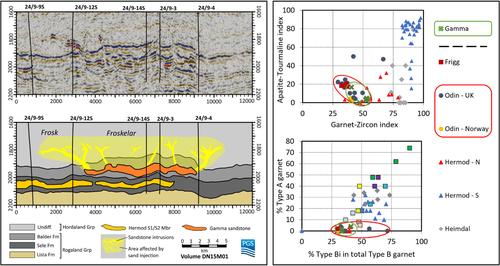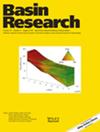注砂或沉积:矿物化学地层学的视角
IF 2.6
2区 地球科学
Q2 GEOSCIENCES, MULTIDISCIPLINARY
引用次数: 0
摘要
应用矿物化学地层学和物源分析方法,对北海北部某来源不明的砂岩体进行了诊断。主要伽玛发现砂岩(24/9-3井)赋存于巴尔德组(早始新世)细粒地层,具有上下面不协调、上覆层自升明显等砂岩侵入体特征。然而,与从地下或露头例子中已知的砂岩侵入体相比,钻孔的总体积和高净比(24/9-3和24/9-14S分别为75%和85%)异常高。为了限定Gamma地区内balder - Fm砂岩的成因,将其重矿物组合(hma)和石榴石化学特征与在地层和地理上接近的Heimdal、Hermod S2、Odin和Frigg段沉积砂岩进行了比较。伽玛砂岩的矿物化学特征与巴尔德组砂岩单元奥丁组沉积砂岩相似。所分析的所有其他沉积砂岩单元都具有不同的矿物化学特征,或者其他因素排除了它们作为伽马砂岩母单元的可能性。我们认为伽玛发现的巴尔德内砂岩占据了其原始地层位置,可以归属于奥丁段,尽管由于原位活化和砂流化导致了内部和外部特征的强烈变化。本文章由计算机程序翻译,如有差异,请以英文原文为准。

Sand Injection or Deposition: A Perspective From Mineral-Chemical Stratigraphy
Mineral-chemical stratigraphy and provenance analysis are applied to aid diagnostics of a sandstone body of uncertain origin in the northern North Sea. The main Gamma discovery sandstone (well 24/9-3), hosted by fine-grained strata in the Balder Formation (early Eocene), has many characteristics of sandstone intrusions, such as discordant upper and lower surfaces and significant jack-up of overlying strata. However, the gross volume and high net-to-gross in boreholes (75% and 85% in 24/9-3 and 24/9-14S, respectively) are unusually high compared with sandstone intrusions known from the subsurface or outcrop examples. To constrain the origin of intra-Balder Fm sandstones in the Gamma area, their heavy mineral assemblages (HMAs) and garnet chemistry are compared with those preserved in depositional Heimdal, Hermod S2, Odin and Frigg Member sandstones found in stratigraphic and geographic proximity. Mineral-chemical characteristics in the Gamma Sandstone are similar to those in depositional sandstone of the Odin Member, a sandstone unit in the Balder Formation. All other depositional sandstone units analysed have dissimilar mineral-chemical features, or other factors preclude them as parent units for the Gamma Sandstone. We conclude that the intra-Balder sandstones in the Gamma discovery occupy their original stratigraphic position and can be assigned to the Odin Member, despite the intense changes to internal and external features caused by in situ remobilisation and sand fluidisation.
求助全文
通过发布文献求助,成功后即可免费获取论文全文。
去求助
来源期刊

Basin Research
地学-地球科学综合
CiteScore
7.00
自引率
9.40%
发文量
88
审稿时长
>12 weeks
期刊介绍:
Basin Research is an international journal which aims to publish original, high impact research papers on sedimentary basin systems. We view integrated, interdisciplinary research as being essential for the advancement of the subject area; therefore, we do not seek manuscripts focused purely on sedimentology, structural geology, or geophysics that have a natural home in specialist journals. Rather, we seek manuscripts that treat sedimentary basins as multi-component systems that require a multi-faceted approach to advance our understanding of their development. During deposition and subsidence we are concerned with large-scale geodynamic processes, heat flow, fluid flow, strain distribution, seismic and sequence stratigraphy, modelling, burial and inversion histories. In addition, we view the development of the source area, in terms of drainage networks, climate, erosion, denudation and sediment routing systems as vital to sedimentary basin systems. The underpinning requirement is that a contribution should be of interest to earth scientists of more than one discipline.
 求助内容:
求助内容: 应助结果提醒方式:
应助结果提醒方式:


